
Papal Coinage
.pdf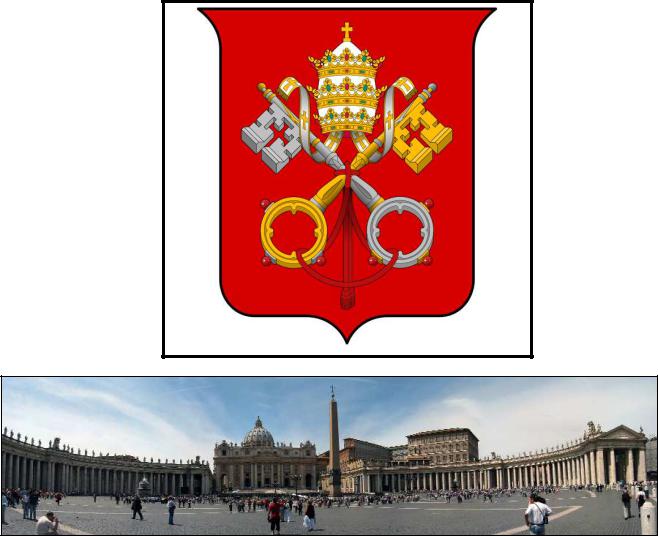
PAPAL
COINAGE
To 1605
NOTES ON PAPAL COINAGE
The Papal Mint is the pope's institute for the production of hard cash. Papal Mint may also refer to the buildings in Avignon, Rome and elsewhere which used to house the mint. (The Italian word for mint is Zecca).
The right to coin money being one of the regalia (sovereign prerogatives), there can be no papal coins of earlier date than that of the temporal power of the popes. Nevertheless, there are coins of Pope Zacharias (741-52), of Gregory III (Ficoroni, "Museo Kircheriano"), and possibly of Gregory II (715-741). There is no doubt that these pieces, two of which are of silver, are true coins, and not merely a species of medals, like those which were distributed as "presbyterium" at the coronation of the popes since the time of Valentine (827). Their stamp resembles that of the Byzantine and Merovingian coins of the seventh and eighth centuries, and their square shape is also found in Byzantine pieces. Those that bear the inscription GREII PAPE — SCI PTR (Gregorii Papæ — Sancti Petri) cannot be attributed to Pope Gregory IV (827-44), because of the peculiarity of minting. The existence of these coins, while the popes yet recognized the Byzantine domination, is explained by Hartmann (Das Königreich It alien, Vol. III), who believes that, in the eighth century, the popes received from the emperors the attributes of "Præfectus Urbis". Under the empire, coins that were struck in the provinces bore the name of some local magistrate, and those coins of Gregory and of Zacharias are simply imperial Byzantine pieces, bearing the name of the first civil magistrate of the City of Rome.
There are no coins of pope Stephen III or of pope Paul I, who reigned when the Duchy of Rome was already independent of the Eastern Empire; the first true papal coins are those of Adrian I, from whose time until the reign of pope John XIV (984) the popes coined money at Rome.
There is no pontifical money of a date between the last-named year and 1305; this is explained, in part, by the fact that the Senate of Rome, which sought to replace the papacy in the temporal government of the city, took over the mint in 1143. On the other hand, Prince Alberic had already coined money in his own name. The coins of the Senate of Rome usually bear the inscription "ROMA CAPUT MUNDI", or, S. P. Q. R., or both, with or without emblems. In 1188 the mint was restored to pope Clement III, with the agreement that half of its profits should be assigned to the sindaco, or mayor. The Senate, meanwhile, continued to coin money, and there is no reference on the coins of that time to the papal authority. In the thirteenth century the Sindaco caused his own name to be stamped upon the coins, and, consequently, we have coins of Brancaleone, of Charles I of Anjou, of Francesco Anguillara, viceroy of Robert of Naples, etc.; so did King Ladislao. Cola di Rienzi, during his brief tribunate, likewise struck coins, with the inscription: N. TRIBUN. AUGUST.: ROMA CAPU. MU.
Papal coins reappeared with the removal of the pontifical Court to Avignon, although there exists a single coin that is referred to Benedict XI (1303-4), with the legend COITAT. VENASIN; as, however, this pope never resided in Venaissin, which had belonged to the Holy See since 1274, the coin should be referred to Benedict XII. There are coins of all the popes from John XXII to Pius IX.
The popes, and also the Senate when it coined money, appear to have used the imperial mint of Rome, which was on the slope of the Campidoglio, not far from the Arch of Septimius Severus; but in the fifteenth century the mint was near the bank of Santo Spirito. Finally, in 1665, Alexander VII moved it to the rear of the apse of St. Peter's. Bernini invented for it a machine to do the work more rapidly, and Francesco Girardini furnished a very sensitive balance; so that the mint of Rome was technically the most perfect one of those times. In 1845 Pius IX equipped it with the most modern appliances.
The administration of the mint was at first entrusted to the cardinal camerlengo; direct supervision, however, was exercised by the senate, from the time at least when that body took possession of the mint, until the reign of pope Martin V. The sindaco and the conservators of the Camera Capitolina appointed the masters of the mint, while the minting was witnessed by the heads of the guild of goldsmiths and silversmiths. In 1322 John XXII created the office of treasurer for the mint of Avignon, and its incumbent, little by little, made himself independent of the camerlengo. Later, the office of prelate president of the mint was created. According to Lunadori (Relaz. della Corte di Roma, 1646), the establishments for the coining of money were in charge of a congregation of cardinals.
Rome was not the only city of the Pontifical States that had a mint: prior to the year 1000, there existed at Ravenna the former imperial mint, which was ceded in 996 to Archbishop Gerberto by Gregory V; there were mints also at Spoleto and at Benevento, former residences of Lombard dukes. The Archbishop of Ravenna, who was a feudatory of the emperor rather than of the pope, coined money as long as his temporal power over that city and its territory lasted. The mint of the Emperor Henry VI was established at Bologna in 1194, and nearly all of the coins struck there bear the motto BONONIA DOCET, or BONONIA MATER STUDIORUM. The baiocchi of Bologna were called bolognini; the gold bolognino was equivalent to a gold sequin. The lira, also a Bolognese coin, was worth 20 bolognini. These coins were struck in the name of the commune; it is only from the time when Bologna was recovered by the Holy See, under Clement VI, that Bolognese coins may be regarded as papal.
All papal coins, with rare exceptions, bear the name of the pope, preceded (until the time of Paul II) by a Greek cross, and nearly all of the more ancient ones bear, either on the obverse or on the reverse, the words S. PETRUS, and some of them, the words S. PAULUS also. From Leo III to the Ottonian dynasty, the coins bear the name of the Holy Roman Emperor as well as that of the pope. After the sixteenth century the coat of arms of the pope alone frequently appears on pontifical coins. There are also found images of the Saviour, or of saints, symbolical figures of men or of animals, the keys (which appear for the first time on the coins of Benevento) etc. From the sixteenth century to the eighteenth, Biblical or moral phrases are added, in allusion to the saint or to the symbol that is stamped upon the coin, e.g. MONSTRA TE ESSE MATREM, SPES NOSTRA, SUB TUUM PRÆSIDIUM, TOTA PULCERA, SUPRA FIRMAM PETRAM, DA RECTA SAPERE (during the Conclave), UBI THESAURUS IBI COR, CRESCENTEM SEQUITUR CURA PECUNIAM, HILAREM DATOREM DILIGIT DEUS, PRO PRETIO ANIMÆ, FERRO NOCENTIUS AURUM, IN SUDORE VULTUS, CONSERVATÆ PEREUNT , TOLLE ET PROIICE, etc. Sometimes allusion is made to an historical event, as the acquisition of Ferrara, or the deliverance of Vienna from the Turks(1683), or to some concession of the pope to his subjects, or to a jubilee year. From the time of Clement X the coins struck at Rome bear a minute representation of the coat of arms of the prelate in charge of the mint, a custom that obtained until 1817. The only instance of a cardinal camerlengo stamping his coat of arms on the coins during the lifetime of the pope is that of Cardinal Armellini, under Adrian VI, in the case of four grossi.
The mints outside of Rome stamped the coins with the arms of their respective cities, or with those of the cardinal legate, of the vice-legate, or of the governor; thus, Cardinal Scipione Borghese in 1612 struck coins at Avignon with his own name and arms, omitting the name of the pope, an example that was followed a year later by the pro-legate Cardinal Filonardi. The city very often placed the image of its patron saint on its coins. The date came to be stamped on coins that were struck during the vacancies of the Holy See, occasionally at first, and later as a rule; it rarely appears on other coins before 1550; the practice became general in the seventeenth century, the year of the Christian era or that of the pontificate being used; and Gregory XVI established it by law, as also the requirement that each coin should bear upon it an expression of its value. At Bologna as early as the seventeenth century, the value of gold or silver coins was usually indicated with the figures 20, 40, 80, etc., i.e. so many bolognini or baiocchi; at Rome, in the eighteenth century, nearly all the copper coins bore an indication of their value. The rim of papal coins rarely bore an inscription; at most, the monogram of the city in which the coin was struck was stamped upon it. From the sixteenth century, the engravers, also, put their ciphers on the coins; among these engravers may be named Benvenuto Cellini, Francesco Raibolini, called il Francia (Bologna), the four Hamerani, Giulio Romano (trident), Cavaliere Lucenti, Andrea Perpenti etc. Until the time of Pius VI, the dies for the mint remained the property of the engravers.
The Byzantine monetary system is followed in the papal coinage until the reign of Leo III, after which the system of the Frankish Empire obtains. John XXII adopted the Florentine system, and coined gold forms, but the weight of this coin varied from 22 to 30 carats (4.4 to 6 g), until Gregory XI reduced it to the original 24 carats (4.8 g); but deterioration came again, and then there were two kinds of florins, the papal florin, which maintained the old weight, and the florin di Camera, the two being in the ratio of 69 papal florins = 100 florins di Camera = 1 gold pound = 10 carlini. The ducat was coined in the papal mint from the year 1432; it was a coin of Venetian origin that circulated with the florin, which in 1531 was succeeded by the scudo, a piece of French origin (écu) that remained the monetary unit of the Pontifical States. At the same time, there appeared the zecchino. The ancient papal florin was equal to 2 scudi and 11 baiocchi (1 baiocco = 0.01 scudi); one ducat was equal to one scudo and 9 baiocchi. The scudo also underwent fluctuations, in the market and in its weight: the so called scudo delle stampe (1595) was worth 184·2 baiocchi, that is, a little less than 2 scudi. Benedict XIII re-established the good quality of the alloy, but under Pius VI it again deteriorated. In 1835 Gregory XVI regulated the monetary system of the Pontifical States, establishing the scudo as the unit, and dividing it into 100 baiocchi, while the baiocco was divided into 5 quattrini (the quattrino, until 1591, had been equal to ¼ of a baiocco). The scudo was coined both in gold and in silver; there were pieces of 10 scudi, called Gregorine; and pieces of 5 scudi, and of 2½ scudi were also coined. The scudo of the eighteenth century was equal to l·65 scudi of Pius VII, which last was adopted by Gregory XVI; the zecchino was worth 2·2 scudi. The scudo is equal to 5·3 lire in the monetary system of the Latin Union. The fractional silver coins were the half scudo, and the giulio, called also paolo, which was equal to 0·1 seudi. The latter coin was created by Julius II in order to put the carlini of Charles of Anjou out of circulation, these coins being of bad alloy. There were pieces of 2 giulii that were called papetti, at Rome, and lire at Bologna, a name that was later given to them officially. A grosso, introduced in 1736, was equal to half a giulio (25 baiocchi); there were also the mezzogrosso, and the testone = 30 giulii. The copper coins were the baiocco or soldo (which was called bolognino, at Bologna) and the 2 baiocchi piece. The name baiocco is derived from that of the city of Bayeux.
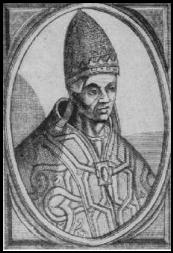
Vitalian - 30 July 657 to 27 Jan. 672
Pope Saint Vitalianus was pope from July 30, 657 until January 27, 672.
He was born in Segni, Lazio, the son of one Anastasius.
After the death of Pope Eugene I, on June 2 or 3, 657, Vitalian was elected his successor, and was consecrated and enthroned on July 30.
Like Eugene, Vitalian tried to restore the connection with Constantinople by making friendly advances to the Eastern Emperor Constans II (641-668) and to prepare the way for the settlement of the Monothelite controversy. He sent letters (synodica) announcing his elevation to the emperor and to Patriarch Peter of Constantinople, who was inclined to Monothelitism. The emperor confirmed the privileges of the Roman Church and sent to Rome a codex of the Gospels in a cover of gold richly ornamented with precious stones as a good-will gesture.
The Patriarch Peter also replied, although his answer was somewhat noncommittal as to Monothelitism, a belief he defended. In his letter, he gave the impression of being in accord with the pope, whose letter to Peter had expounded the Catholic Faith. Thus ecclesiastical intercourse between Rome and Constantinople was restored, but the mutual reserve over the dog-
matic question of Monothelitism remained. Vitalian's name was entered on the diptychs of the Byzantine Church--the only name of a pope so entered between the reign of Honorius I (d. 638) and the Sixth Ecumenical Council of 680-81.
The inclusion of Vitalian's name on the diptych was seen as some as being too conciliatory towards heresy, but that charge was unfounded.
Vitalian showed reciprocity toward Constans, when the latter came to Rome in 663, spending twelve days there during a campaign against the Lombards. On 5 July the pope and members of the Roman clergy, met the emperor at the sixth milestane and accompanied him to St. Peter's, where the emperor offered gifts. The following Sunday, Constans went in state to St. Peter's, offered a pallium wrought with gold, and was present during the Mass celebrated by the pope. The emperor dined with the pope on the following Saturday, attended Mass again on Sunday at St. Peter's, and after Mass took leave of the pope. On his departure Constans removed a large number of bronze artworks, including the bronze tiles from the roof of the Pantheon, which had been dedicated to Christian worship.
Constans then moved on to Sicily, oppressed the population, and was assassinated at Syracuse in 668. Vitalian supported Constans' son Constantine IV against a usurper and thus helped him attain the throne. As Constantine had no desire to maintain the Monothelite decree (typus) of his father, Pope Vitalian made use of this inclination to take a more decided stand against Monothelitism and to win the emperor over to orthodoxy. In this latter attempt, however, he did not succeed. The Monothelite patriarch Theodore of Constantinople removed Vitalian's name from the diptychs. It was not until the Sixth Ecumenical Council (681) that Monothelitism was suppressed, and Vitalian's name was replaced on the diptychs of the Byzantine Church.
Pope Vitalian was successful in improving relations with England, where the Anglo-Saxon and British clergies were divided regarding various ecclesiastical customs. At the Synod of Streaneshalch, King Oswy of Northumberland accepted Roman practices regarding the keeping of Easter, and the shape of the tonsure. Together with King Egbert of Kent, he sent the priest Wighard to Rome, to be consecrated there after the death of Archbishop Deusdedit of Canterbury in 664, but Wighard died at Rome of the plague.
Vitalian wrote to King Oswy promising to send a suitable bishop to England as soon as possible. Hadrian, abbot of a Neopolitan abbey, was selected, but he considered himself unworthy to be bishop. At his recommendation a highly educated monk, Theodore of Tarsus, who understood both Latin and Greek, was chosen as Archbishop of Canterbury and consecrated on 26 March, 668. Accompanied by Abbot Hadrian, Theodore went to England, where he was recognized as the head of the Church of England.
The archiepiscopal See of Ravenna reported directly to Rome. Archbishop Maurus of Ravenna (648-71) sought to end this dependence, and thus make his see autocephalous. When Pope Vitalian called upon him to justify his theological views, he refused to obey and declared himself independent of Rome. The pope excommunicated him, but Maurus did not submit, and even went so far as to excommunicate the pope.
Emperor Constans II sided with the archbishop and issued an edict removing the Archbishop of Ravenna from the patriarchal jurisdiction of Rome, and ordained that the former should receive the pallium from the emperor. The successor of Maurus, Reparatus, was in fact consecrated, in 671. It was not until the reign of Pope Leo II (682-83) that the independence of the See of Ravenna was suppressed: Emperor Constantine IV repealed the edict of Constans and confirmed the ancient rights of the Roman See over the See of Ravenna.
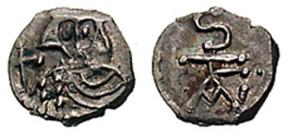
Vitalian enforced his authority as supreme pontiff in the Eastern Church. Bishop John of Lappa, had been deposed by a synod under the presidency of the Metropolitan Paulus. John appealed to the pope, and was imprisoned by Paulus for so doing. He escaped, however, and went to Rome, where Vitalian held a synod in December, 667, to investigate the matter, and pronounced John guiltless. He then wrote to Paulus demanding the restoration of John to his diocese, and the return of the monasteries which had been unjustly taken from him. At the same time the pope directed the metropolitan to remove two deacons who had married after consecration.
The introduction of church organ music is traditionally believed to date from the time of Vitalian's papacy.
Vitalian was considered a firm ruler of the Church, one who preserved discipline. He died January 27, 672. Venerated as a saint, his feast is kept on that date.
PAPAL COINS
CONSTANTINE IV (668-685) and POPE ST. VITALIAN (657-672).
AR 1/8 Siliqua. Rome mint. 0.26 g.
Obv.:Crowned and beardless facing bust, wearing chlamys and holding globus cruciger
Rev.: Elongated monogram of Pope Vitalian.
Reference: M.D. O’Hara and I. Vecchi, “A Find of Byzantine Silver from the
Mint of Rome for the Period AD 641-752,” SNR 64 (1985), 15; SB 1233A;
Berman 8 (Pope Stephen III or IV). EF, flan chip, some weakness in obverse.
Extremely rare.
This class was unknown before 1985 and is of considerable interest. It was during the pontificate of Vitalian that the first visit by an Emperor to Rome in over three hundred years, by Constans II in 663, ended in a public relations disaster. Constans II’s campaigns against the Lombards invariably meant the ruthless extortion of his Italian subjects, added to which the infamous despoiling of the gilded roof of the Pantheon gave him a reputation almost as bad as Gaiseric.
Estimate $3000 Sold For $4750
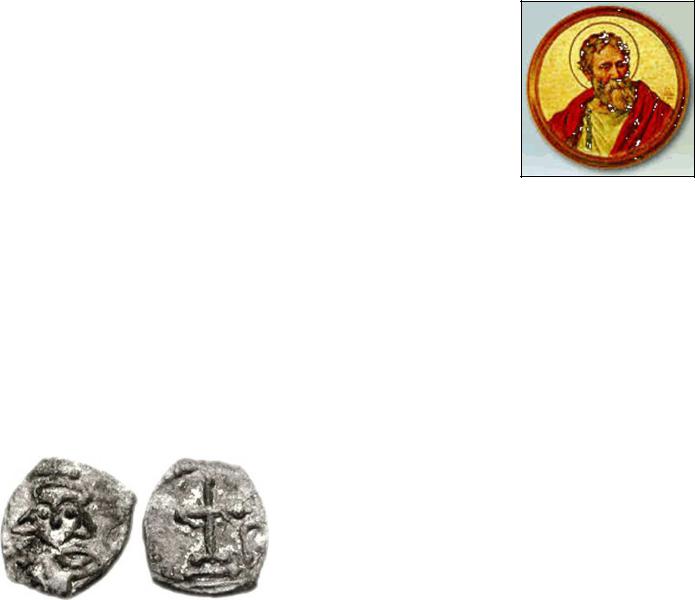
Agatho - 27 June 678 to 10 Jan. 681
Pope Saint Agatho (c. 577 – January 10, 681) was pope from June 27, 678 to January 10, 681.
A Greek born in Sicily of wealthy and devout parents, he allegedly gave away his inheritance after their death and retired to a monastery in Palermo. This belief is based on a letter written by St. Gregory the Great to the abbot of St. Hermes in Palermo, a Benedictine Monastery, mentioning an Agatho. In this letter, Gregory wrote that the abbot could receive Agatho into his monastery if Agatho's wife was willing to enter a convent. While there are reasons to believe that Pope Agatho is this monk, he would have been over 100 years old at the time of his election.
Shortly after Agatho became Pope, St Wilfrid, Archbishop of York, arrived at Rome to invoke the authority of the Holy See in his behalf. Wilfrid had been deposed from his see by Theodore, Archbishop of Canterbury, who had carved up Wilfrid's diocese, appointing three bishops to govern the new sees. At a synod which Pope Agatho convoked in the Lateran to investigate the
affair, it was decided that Wilfrid's diocese should indeed be divided, but that Wilfrid himself should name the bishops.
The major event of his pontificate was the Sixth Ecumenical Council (680–1), which ended the Monothelite heresy that had been tolerated by previous popes (Honorius among them). The council began when Emperor Constantine IV, desired to heal the schism that separated the two sides. He wrote to Pope Donus suggesting a conference on the matter, but Donus was dead by the time the letter arrived. However, Agatho was quick to seize the olive branch offered by the emperor. He ordered councils held throughout the West so that legates could present the universal tradition of the Western Church. Then he sent a large delegation to meet the Easterners at Constantinople. The legates and patriarchs gathered in the imperial palace on November 7, 680. The Monothelites presented their case. Then the letter of Pope Agatho was read which explained the traditional belief of the Church that Christ was of two wills, divine and human. The council agreed that Peter spoke through Agatho. Patriarch George of Constantinople accepted Agatho's letter, as did most of the bishops present. The council proclaimed the existence of the two wills in Christ and condemned Monothelitism, with Pope Honorius being included in the condemnation. When the council ended in September of 681 the decrees were sent to the Pope, but Agatho had died in January. The Council had not only ended the Monothelite heresy, but had healed the schism. Agatho also undertook negotiations between the Holy See and Constantine, concerning the relations of the Byzantine Court to papal elections. Constantine promised Agatho to abolish or reduce the tax that the popes had had to pay to the imperial treasury on their consecration. He is venerated as a saint by both Latins and Greeks.
Some Traditionalist Catholics say he was the first pope to take, as part of his inauguration, what they call the Papal Oath.
PAPAL COINS
Constantine IV Pogonatus. 668-685. Struck under Pope St. Agatho (678-681).
AR 1/8 Siliqua30 Nummi. Rome mint. 0.26 g.
Obv.: Crowned bust facing with triangular locks of hair, wearing chlamys and holding globus cruciger in right hand.
Rev.: Cross on base with two steps; A suspended from left bar of cross (partially visible); R in right field. Unpublished. VF, toned. Unique.
The letter R in the reverse field probably indicates Roma, and A the reigning pope. As the coin depicts a conventional likeness of Constantine IV on the obverse and a letter A on the reverse, the only possible candidates would appear to be Pope Agatho (27th June 678 -10th January 681) or Pope Adeodatus II (11th April 672 - 17th June 676).
This important new coin in this historically significant, newly discovered series (1985) would seem to represent yet another pope striking coins in his own name, thereby claiming temporal sovereignty. Pope Adeondatus did not enjoy amicable relations with the government or clergy at Constantinople and the reign has been described as ‘extremely obscure’ (Kelly p. 78). Pope Agatho, a Sicilian and ex monk who spoke both Greek and Latin, was an able administrator who broke from precedent, in view of the stringency of the church finances, in order to undertake the office of treasurer (acarius) of the Holy See until ill health obliged him to relinquish it. This particular pope, therefore, with his specific financial experience and knowledge, would certainly have appreciated the significance of coinage both as a political and fiscal medium. Although a short reign, it was important for a number of events, but particularly for the abandonment of Monothelitism by the Byzantine government and the resultant reopening of good relations between the Holy See and Constantinople.
The sheer number of new classes and varieties with the classes which have come to light so far in this series would seem to suggest a much larger coinage initially in circulation that the actual number of coins recorded to date might indicate.
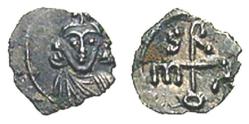
Sergius I - 15 Dec. 687 to 8 Sept. 701
Pope Sergius I (d. September 8, 701) was Pope from 687–701. He came from an Antiochene Syrian family which had settled at Palermo in Sicily, and owed his election as Pope Conon's successor to skillful intrigues against Paschalis and Theodorus, the other candidates. He was consecrated on December 15, 687.
On April 10, 689, he baptised King Caedwalla of Wessex in Rome. For rejecting certain canons of the Trullan (Quinisext) council of 692, Justinian II ordered his arrest and transportation to Constantinople, but the militia of Ravenna and the Pentapolis forced the imperial protospatharius to abandon the attempt to carry out his orders. Sergius ordained Saint Willibrord as bishop of the Frisians, and the Liber Pontificalis states he also ordained Berhtwald as Archbishop of Canterbury. Sergius died in 701.
PAPAL COINS
JUSTINIAN II. First Reign (685-695) and POPE ST. SERGIUS (687-698).
AR 1/8 Siliqua30 Nummi. Rome mint. 0.26 g.
Obv.: Crowned and beardless facing bust, wearing chlamys.
Rev.: Full monogram of Rome, S in upper left field.
Reference: O’Hara/Vecchi, 21(this coin); SB 1308A; Berman 6 (Pope Stephen II or III). EF, flan chip, slightly off-center, but nicely toned and of refined portrait style. Unique. There were 31 coins in the O’Hara/Vecchi Hoard, and this was the most aesthetic and stylistically pleasing coin in the entire hoard.
Although Pope Sergius was appointed by the personal intervention of the Byzantine exarch, he was a strong defender of Roman rights, and the ensuing efforts of Justinian to have him deported to Constantinople weakened the imperial position in Italy. [New Paragraph] Through the pontificate of Sergius the Italo-Byzantine territories continued to have less connection with the empire. The exarchate of Ravenna showed signs of an autonomous entity, the Romagna. The duchy of Rome submitted to the pope, leaving only Naples, Calabria and Sicily loyal to Constantinople, which with the adoption of the iconoclastic heresy widened even further the rift between the papacy and the Byzantine emperor.
Estimate $4000 Sold For $4500
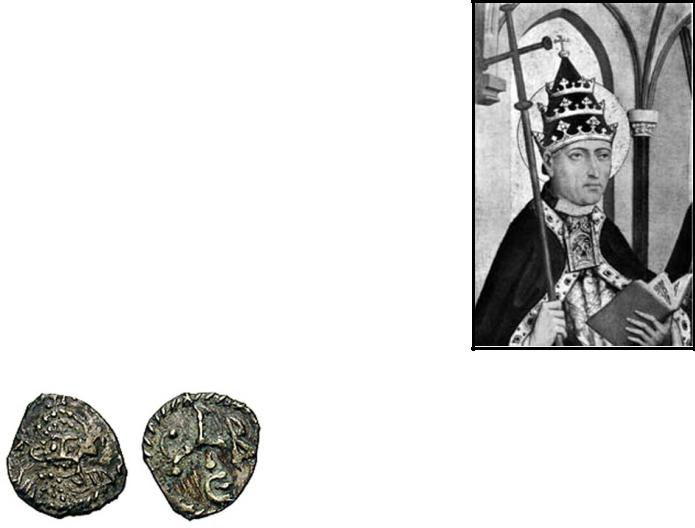
Gregory II - 19 May 715 to 11 Feb. 731
Pope Gregory II served as pope from May 19, 715 to his death on February 11, 731, succeeding Pope Constantine. Having, it is said, bought off the Lombards for thirty pounds of gold, he used the tranquillity thus obtained for vigorous missionary efforts among the Germanic tribes, and for strengthening the papal authority in the churches of Britain and Ireland. By excommunicating the Byzantine emperor Leo III the Isaurian, he prepared the way for a long series of revolts and civil wars, which tended greatly to the establishment of the temporal power of the popes. He died in 731, and subsequently attained the honour of canonization. The day that Gregory is remembered in the "Martyrology" seems to be any one of February 11th, February 13th, and February 28th.
Gregory II was an alleged collateral ancestor to the Roman Savelli family, according to a 15th century chronicler, but this is undocumented and very likely unreliable. The same was said of Benedict II, but nothing certain is known about a kinship between the two popes.
PAPAL COINS
LEO III (717-741) and POPE ST. GREGORY II (715-731).
AR 1/8 Siliqua . 0.26 g. Struck circa 717-731.
Obv.: Crowned and bearded facing bust, wearing chlamys and holding cross cruciger in right hand; star in upper field left and right.
Rev.: G R E O around central cross.
Reference: O’Hara/Vecchi 29; DOC III 92 (Leo III); MEC 1030 (Gregory III); SB 1534C (Gregory III). EF, very light encrustation. ($1000) This type was previously attributed to Gregory, exarch of Africa who revolted against Constans II in 647, or to duke Gregory of Benevento (732-739). However its presence in the papal-Byzantine hoard confirms its present identification.
Gregory II was a strong and able pope who resisted the iconoclast edicts eminating from Constantinople and survived a number of attacks on his life instigated, some say, by agents of Leo III. When Liutprand, king of the Lombards (712-744), resumed a policy of expansion and unification, the papacy found itself completely isolated, appealing without success in 739 for help to the Frankish king Charles Martel, who was too busy defending his kingdom against the Moors. It took Pepin III (‘the Short”), the son of Charles Martel, to take the initiative and come to an understand - ing first with Pope Zacharias and later Pope Stephen II, who in 754 visited Gaul to request military help against the Lombards.
Estimate $1000 Sold For $1200
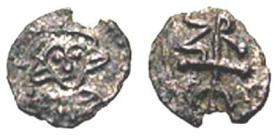
Zacharias - 3 Dec. 741 to 14 March/22 March 752
Pope Saint Zachary (Greek Zacharias), pope (741-752). He came from a Greek family of Calabria. Most probably he was a deacon of the Roman Church and as such signed the decrees of the Roman council of 732; and was on intimate terms with Gregory III, whom he succeeded in December 10, 741.
Zachary was a wise and subtle diplomat. Finding that his predecessor's alliance with the Lombard Duke of Spoleto was not protecting Papal cities against the Lombard king, Zachary turned to Liutprand directly. Contemporary history (Liber pontificalis) dwells chiefly on Zachary's great personal influence with Liutprand, and with his successor Ratchis; his tact in dealing with these princes in a variety of emergencies contributed to save the exarchate of Ravenna from the Lombard attacks.
A correspondence, of considerable extent, and great interest, between Zachary and Saint Boniface, the apostle of Germany, survives, and shows how great was the influence of this pope on events then passing in France and Germany; he encouraged the deposition of the last Merovingian king of the Franks, Childeric III, and it was with his sanction that Boniface crowned Pepin the Short as King of the Franks at Soissons in 752. Zachary is stated to have remonstrated with the Byzantine emperor Constantine V Copronymus on the part he had taken in the iconoclastic controversy. He died March 22, 752, and buried in St. Peter's Basilica. His successor was Stephen who died soon after, before consecration and is not considered a valid pope. He was then succeeded by another Stephen who became Stephen II.
In the effort to Christianize Rome, Zachary built the original church of Santa Maria sopra Minerva over an ancient temple to Minerva near Pantheon. He also restored the Lateran Palace, moving the relic of the head of Saint George to the church of San Giorgio al Velabro.
The letters and decrees of Zachary are published in Jacques Paul Migne, Patrolog. lat. lxxxix. p. 917-960.
PAPAL COINS
CONSTANTINE V and POPE ZACHARIAS. 741-752 AD.
AR 1/8 Siliqua . Rome mint. 0.13 g.
Obv.: Crowned beardless facing bust, wearing chlamys; cross in left field.
Rev.: Rm monogram; Z (Zacharias) in upper left field.
Reference: M.D. O’Hara and I. Vecchi, “A Find of Byzantine Silver from the Mint of Rome for the Period AD 641-752,” SNR 64 (1985), 20 [Hoard nos. 3031]; Berman 4; SB 1579 (not priced!). EF, flan chip. Extremely rare - the finest of just three known specimens. ($2000) This class was unknown before 1985 and is of considerable interest. Its existence shows that the silver coins at present listed in the various standard works under Constantine V for Rome, those with the reverse type K combined with a cross and emperor wearing a loros, must be re-attributed to Pope Constantine. Zacharias is also known to have issued square bronze tessere, cf. Berman pg. 31, 5. (NEW PARAGRAPH)Pope (and St.) Zacharias is noteworthy in history for his momentous decision to bless St. Boniface’s anointment of Pepin the Short as king of the Franks. In 751, Zacharias appealed for the Franks’ help against Aistulf, who had taken Ravenna and was demanding suzerainty over Rome as part of his enlarged dominion of the Lombards.
Estimate $2000 Sold For $2000
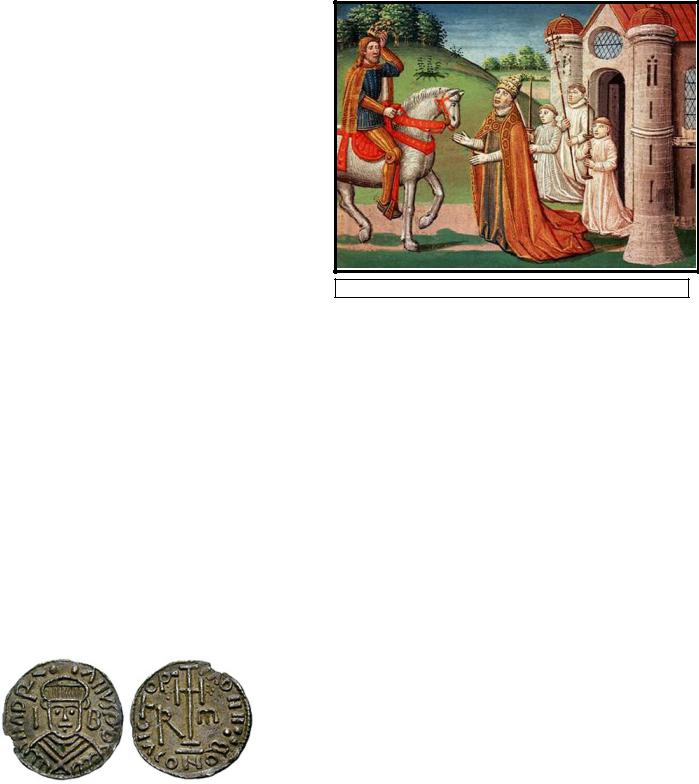
Adrian I - 1 Feb. 772 to 26 Dec. 795
Pope Adrian, or Hadrian I, (d. December 25, 795) was pope from February 9, 772 to December 25, 795. He was the son of Theodore, a Roman nobleman.
Soon after his accession, the territory ruled by the popes was invaded by Desiderius, king of the Lombards, and Adrian found it necessary to invoke the aid of the Frankish king Charlemagne, who entered Italy with a large army, besieged Desiderius in his capital of Pavia, took that town, banished the Lombard king to Corbie in France and, in an innovative gesture, took the title 'King of the Lombards' himself. The pope, whose expectations had been aroused, had to content himself with some additions to the duchy of Rome, and to the Exarchate of Ravenna, and the Pentapolis in the Marches, which consisted of the "five cities" on the Adriatic coast from Rimini to Ancona with the coastal plain as far as the mountains.
A mark of such newly settled conditions in the Duchy of Rome is the Domusculta Capracorum, the central villa on the Roman plan that Adrian assembled from a nucleus of his
inherited estates and acquisitions from neighbors in the countryside north of Veii. The villa is documented in Liber Pontificalis but its site was not rediscovered until the 1960s, when excavations revealed the structures on a gently rounded hill that was only marginally capable of self-defense but fully self-sufficient, with its own grain mill, smithies and tile-kilns, for a mixed economy of grains and vineyards, olives, vegetable gardens and piggery. In the tenth century, villages were carved out of Adrian's Capracorum estate: Campagnano mentioned first in 1076, Formello mentioned in 1027, Mazzano in 945, and Stabia (modern Faleria) in 998.
In his contest with the Byzantine Empire and the Lombard dukes of Benevento, Adrian remained faithful to the Frankish alliance, and the friendly relations between pope and king were not disturbed by the difference which arose between them on the question of the veneration of images, to which Charlemagne and the bishops in France were strongly opposed, while Adrian favoured the views of the Eastern Church, and approved the decree of the second council of Nicaea (787), confirming the practice and excommunicating the iconoclasts. It was in connection with this controversy that the Libri Carolini were written, to which Adrian replied by letter, anathematizing all who refused to venerate the images of Jesus, or the Virgin Mary, or saints. Notwithstanding this, a synod, held at Frankfurt in 794, anew condemned the practice, and the dispute remained unsettled at Adrian's death.
In 787, he elevated the diocese of Lichfield, in England, to an archdiocese on request from the English bishops and King Offa of Mercia in order to balance the ecclesiastic power in that land between Kent and Mercia. He gave the Lichfield bishop Higbert the pallium in 788.
An epitaph written by Charlemagne in verse, in which he styles Adrian "father," is still to be seen at the door of the Vatican basilica. Adrian restored some of the ancient aqueducts of Rome, and rebuilt the churches of Santa Maria in Cosmedin, decorated by Greek monks fleeing from the iconoclastal persecutions, and of San Marco in Rome. At the time of his death, his was the longest papacy since Saint Peter, and it would remain so until he was surpassed by the 24-year papacy of Pius VI in the late 18th century. In fact, only three more popes (Pius IX, John Paul II and Leo XIII) have reigned longer since.
PAPAL COINS
HADRIAN I. 772-795.
AR Denaro. Struck circa 781-795.
Obv.: HADRIANVS P^P>, bust of Hadrian facing; in field, I-B
Rev.: VICTOR-IA DNN :., cross potent on two steps, flanked by R-m; in exergue, CONOB.
Reference: MEC 1032; Muntoni I pg. 3, 1; Serafini I pg. 4, 3; CNI XV pg. 63, 5; Berman 210 (this plate coin). Extremely rare. EF, fine toning.
Estimate $10000 Sold For $18000
